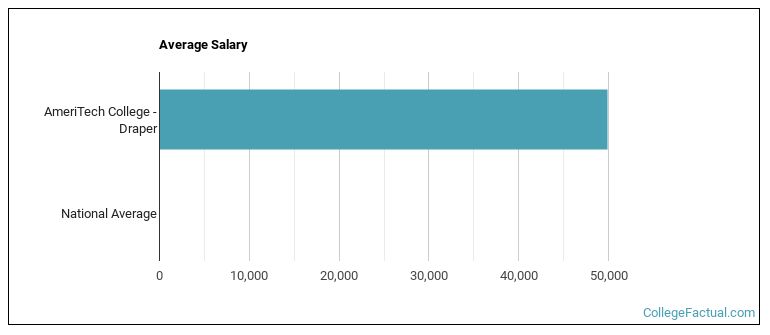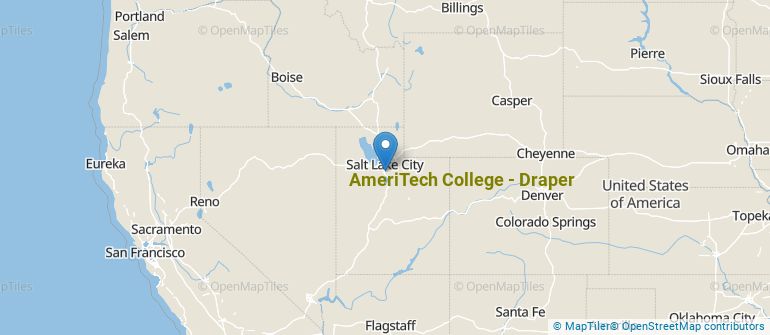 by our College Data Analytics Team
by our College Data Analytics TeamCollege Factual analyzes over 2,000 colleges and universities in its annual rankings and ranks them in a variety of ways, including most diverse, best overall quality, best for non-traditional students, and much more.
AmeriTech College - Draper was awarded 21 badges in the 2025 rankings. The highest ranked major at the school is health professions.
Explore the best ranked schools for the programs you are most interested in.
AmeriTech College - Draper was not ranked in College Factual's 2025 Best Overall Colleges report. This could be for a number of reasons, including lack of data.
AmeriTech College - Draper has an acceptance rate of 97%, so it is easier to gain admission to this school than some others. Still, the admissions staff will examine your application closely to make sure you're a good fit for AmeriTech College - Draper.
The student to faculty ratio is often used as a measure to gauge how much access students will have to their professors - the lower the number, the better. At AmeriTech College - Draper, this rate is 23 to 1, which is high when compared to the national average of 15 to 1.
Another measure that is often used to estimate how much access students will have to their professors is how many faculty members are full-time. The idea here is that part-time faculty tend to spend less time on campus, so they may not be as available to students as full-timers.
The full-time faculty percentage at AmeriTech College - Draper is 43%. This is comparable to the national average of 47%.
The freshmen retention rate of 82% tells us that most first-year, full-time students like AmeriTech College - Draper enough to come back for another year. This is a fair bit higher than the national average of 68%. That's certainly something to check off in the good column about the school.
During the 2017-2018 academic year, there were 1,309 undergraduates at AmeriTech College - Draper with 1,026 being full-time and 283 being part-time.
| $0-30 K | $30K-48K | $48-75 | $75-110K | $110K + |
|---|---|---|---|---|
| $29,427 | $30,170 | $30,196 | $32,110 | $32,259 |
The net price is calculated by adding tuition, room, board and other costs and subtracting financial aid.Note that the net price is typically less than the published for a school. For more information on the sticker price of AmeriTech College - Draper, see our tuition and fees and room and board pages.
It's not uncommon for college students to take out loans to pay for school. In fact, almost 66% of students nationwide depend at least partially on loans. At AmeriTech College - Draper, approximately 99% of students took out student loans averaging $12,142 a year. That adds up to $48,568 over four years for those students.
Get more details about paying for AmeriTech College - Draper.

See which majors at AmeriTech College - Draper make the most money.
Get more details about the location of AmeriTech College - Draper.

Contact details for AmeriTech College - Draper are given below.
| Contact Details | |
|---|---|
| Address: | 12257 South Business Park Drive, Draper, UT 84020-6545 |
| Phone: | 801-816-1444 |
| Website: | www.joyce.edu/ |
| Most Popular Majors | Bachelor’s Degrees | Average Salary of Graduates |
|---|---|---|
| Nursing | 778 | $74,693 |
| Allied Health & Medical Assisting Services | 25 | NA |
Online learning is becoming popular at even the oldest colleges and universities in the United States. Not only are online classes great for returning adults with busy schedules, they are also frequented by a growing number of traditional students.
In 2022-2023, 2,304 students took at least one online class at AmeriTech College - Draper. This is an increase from the 1,957 students who took online classes the previous year.
| Year | Took at Least One Online Class | Took All Classes Online |
|---|---|---|
| 2022-2023 | 2,304 | 0 |
| 2021-2022 | 1,957 | 218 |
| 2020-2021 | 1,429 | 227 |
| 2018-2019 | 335 | 78 |
Learn more about online learning at AmeriTech College - Draper.
Footnotes
*The racial-ethnic minorities count is calculated by taking the total number of students and subtracting white students, international students, and students whose race/ethnicity was unknown. This number is then divided by the total number of students at the school to obtain the racial-ethnic minorities percentage.
References
More about our data sources and methodologies.